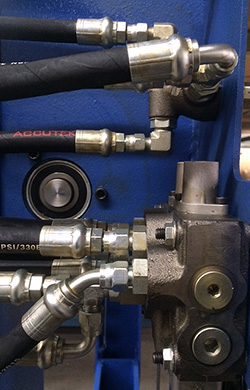Treat your hydraulic press with a schedule of regular upkeep. The reward is you’ll increase its lifespan, experience less downtime and save substantial money on repairs.
Keeping your machinery efficient helps the operator to get the job done right the first time. Your workflow is smoother as a result, with fewer bottlenecks. When your equipment is at peak running efficiency, you have less wasted material. Your customers are happier with the work and with the turnaround.
What Can Go Wrong
Any time you hear noises that are unexpected, feel different types of vibrations or see something that is even slightly off, it’s time to take a closer look. Don’t let problems grow into major repairs.
This is why a daily inspection of your hydraulic presses is so important. It gives a trained operator the time and closer look that will spot many potential problems while they are still in the fixable stage.
This daily inspection is part of a sensible preventive maintenance checklist for your machine shop. For both an H-frame press and a C-frame hydraulic press, you need to make use of a hydraulic press maintenance checklist to be sure you are doing a proper job of preventive maintenance.
What to Look for Every Day
To keep your press running day after day, do a short but thorough inspection of the following parts.
Oil leaks on hydraulic lines. These can happen quickly, starting small but rapidly turning into a major mess. Take the time to tighten fittings that are loose and causing the leaks. Wipe off the excess oil so you can spot new leaks easier.
Oil level. Top it off if it is below the recommended level. Follow the manufacturer’s suggestions for the right type of oil to use.
Loose bolts. Vibration and shock take a toll. Bolts can easily become loose.
Guided platens. Make sure the bushings on appropriate machinery are greased, maintaining a thin layer of lubrication over the rod.
Be sure to check your machine’s bushings because not all benefit from regular lubrication. If they are impregnated with graphite, follow the guidelines in the press manual.
Oil temperature. You want to strive for 120 degrees F.
Ram. Inspect the ram to make sure it is not dripping in oil. It should only be kept moist.
Light curtains. When you break the beam as the ram goes downward, a well maintained press should stop right away. However, you can’t test this on the upstroke.
Oil Inspections
Just like your car, your press needs the oil maintained in order to run regularly and reliably. That means keeping to a schedule for checking that it has the right amount of oil, in the proper amounts, that it is clean and suitable for your press.
Here are the major points to remember:
-
Keep the temperature at close to 120 degrees F.
-
Keep your air and water coolers in good shape.
-
Keep the radiator clean of dust.
-
Sample the oil on an annual basis. Look for signs of contamination and the proper fluid properties.
Electrical Inspections
The electronic system on your press probably has a lifecycle of three million strokes. Relays last about one million. This means they last a long time, but they will wear out. Plan for it by replacing them before they break down and quit. This saves money on downtime and on repair costs.
Use an hour meter and cycle counter, the type that can’t be reset, so you have records you can rely on. Guessing where it is in its lifecycle won’t help you. Check the control wiring at least once a year. You need to make sure all the fittings are firmly connected and the wiring isn’t showing signs of wear. Clean dust and debris from the enclosures at the same time. This reduces unnecessary wear.
Put together a reporting system so problems get handled as quickly as possible. Make sure your operators know how to report potential difficulties.
Following this type of scheduled maintenance system will keep your shop running smoothly and safe you significant amounts on repairs and replacement costs.

